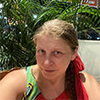Have you ever tried to transfer an image from a photo to a watercolor, but found that things end up crooked? Or disproportionate? Or in the wrong place?
You can solve these problems. There are lots of ways to solve these problems. But first, you should learn gridding. Gridding is not the be-all and end-all, but it will definitely help you get there.
Watercolor painting offers you both spontaneity and control. I don't know about you, but that's one of the things I find most fascinating in it.
But making the painting look like the model--that's tough!
Gridding to the rescue! Gridding will help you get everything straight. Your output won't look like Naive Art unless that's what you want. Gridding will make sure that you get the proportions right. And it will enable you to put everything in the right places. Without squelching your creativity.
I learned gridding in art class way back in high school. Thank you Mrs. Adams!
Now I get to pass the secret of transferring images on to you. No major errors. Good lines. Good proportion. No tracing. Welcome to grinding...
Your grid lines will be your guide as you conquer Mount Painting.
You will breathe yourself into your artwork. Your gridlines will help you go from the lowlands of poor imitation to the glorious heights of great art. You will capture the essence of your subject, but with your own style and interpretation.
The first thing is to choose a photo that you like. You could go with a photo that you don't like, but why?
Next, you want to print out your photo. You want to draw your gridlines onto the printout. Oh! It just occurred to me that this might be why we call it gridding.
By the way, make sure your gridlines are light, so that you’ll be able to easily erase them later on. It can help to use a H pencil.
At first, use a grid with lots of little squares. This will make it easier for you to capture the details of your image.
Now that you've got your photo gridded, you're free of the extra challenge of freehand drawing. Great! So you can enjoy the creative challenge of the actual painting.
You'll need to create a grid on your watercolor paper. This grid should match the one on the photo. I mean that it should have the same number of squares. The squares will be bigger or smaller, to adapt the image to the size of painting you want.
Next, focus on one square of the original photo. One square. Draw the picture as it appears there onto your watercolor paper. Don't worry about anything else. Focus on reproducing that one square with the details that you want. When you finish one square, move on to the next.
As you draw, you'll notice different ways of capturing the essence of the image. You'll learn which details are essential and which you can leave to the imagination. If you find you made a mistake, no problem. Erase carefully and do over. A kneaded eraser can be useful, as it allows you to spot erase.
When all your squares are complete, take a look at the total picture you drew. Now's the time to add details and depth that you may have left out in the transfer stage.
When your drawing is complete, make sure you erase the gridlines!
Now you're ready to paint.
If your first effort isn't ideal, be patient with yourself. All good things come with practice.
This skill is a solid foundation to your watercolor painting career. Of course, the more you grid, the better you will become.
Over time, you will find that your grids won't need to be so tight. That's great! It means you're getting better! Finally your eye will be so trained you won't need a grid at all.
Learn about the next step: color mixing from this video and more tips in this one.



